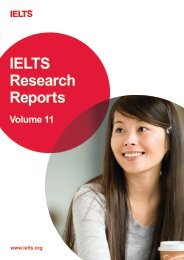INTRODUCTION - ielts
INTRODUCTION - ielts
INTRODUCTION - ielts
You also want an ePaper? Increase the reach of your titles
YUMPU automatically turns print PDFs into web optimized ePapers that Google loves.
Paul Seedhouse and Maria Egbert explored the interactional organisation of the IELTS<br />
Speaking Test in terms of turn-taking, sequence and repair, drawing their sample for analysis<br />
from the large corpus of audio-recordings held by Cambridge ESOL. Since 2002 several<br />
thousand recordings of live IELTS Speaking Tests have been collected and these now form a<br />
valuable spoken language corpus used by researchers at Cambridge ESOL to investigate various<br />
aspects of the Speaking Test. By applying Conversation Analysis (CA) methodology to 137<br />
complete speaking tests, Seedhouse and Egbert were able to highlight key features of the spoken<br />
interaction.<br />
Like O’Sullivan and Yang, they observed that examiners adhere closely to the scripted guide<br />
they are given to ensure standardisation of the test event. Although spoken interaction in the<br />
IELTS Speaking Test is somewhat different to ordinary conversation due to the institutional<br />
nature of the test event, the researchers confirm that it does share similarities with interactions in<br />
teaching and academic contexts. In addition, the three parts of the Test allow for a variety of<br />
task types and patterns of interaction. Seedhouse and Egbert make a number of useful<br />
recommendations which will inform aspects of test design as well as examiner training,<br />
particularly in relation to the rounding-off questions at the end of Part 2.<br />
In the final report in Volume 6, John Read and Paul Nation investigated the lexical dimension<br />
of the IELTS Speaking Test. Allocation of grant funding for this study once again reflected the<br />
IELTS partners’ concern to undertake validation work following introduction of the revised<br />
Speaking Test in 2001. When the holistic or global scale for speaking was replaced with four<br />
analytic criteria and scales in July 2001, one of these four was Lexical Resource; this requires<br />
examiners to attend to the accuracy and range of a candidate’s vocabulary use as one basis for<br />
judging their performance. The Read and Nation study therefore set out to measure lexical<br />
output, variation and sophistication, as well as the use of formulaic language by candidates. As<br />
the researchers point out in their literature review, there was a strong motivation to explore<br />
speaking assessment measures from a lexical perspective given the relative lack of previous<br />
research on spoken (rather than written) vocabulary and the growing recognition of the<br />
importance of lexis in second language learning.<br />
For this study the researchers created a small corpus of texts derived from transcriptions of<br />
Speaking Tests recorded under operational conditions at IELTS tests centres worldwide. As for<br />
the Seedhouse and Egbert study, they were given access to the corpus of IELTS Speaking Test<br />
recordings at Cambridge ESOL from which they selected a subset of 88 performances for<br />
transcription and analysis.<br />
The study’s findings are broadly encouraging for the IELTS test developers, confirming that the<br />
Lexical Resource scale does indeed differentiate between higher and lower proficiency<br />
candidates. At the same time, however, the study highlights the complexity of this aspect of<br />
spoken performance and the extent to which candidates who receive the same band score<br />
sometimes display markedly different qualities in their individual performance. The study also<br />
provides useful insights into how different topics in Parts 2 and 3 influence the nature and extent<br />
of lexical variation. Such insights can feed back into the test writing process; they can also<br />
inform the training of IELTS examiners to direct their attention to salient distinguishing features<br />
of the different bands and so assist them in being able to reliably rate vocabulary performance as<br />
a separate component from the other three rating criteria. The researchers suggest that in the<br />
longer term, and following additional research into how this scale operates, there may be a case<br />
for some further revision of the rating descriptors.

















